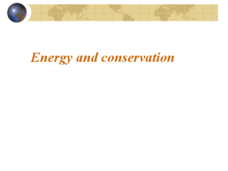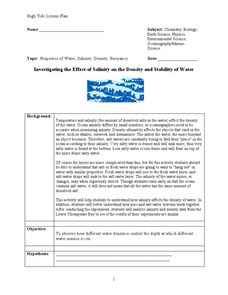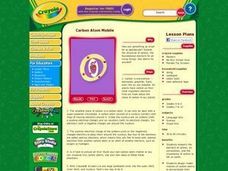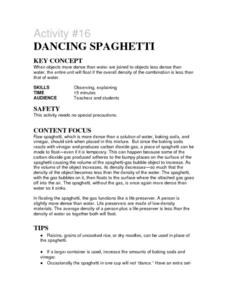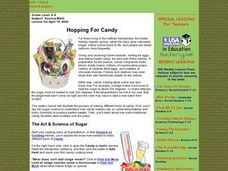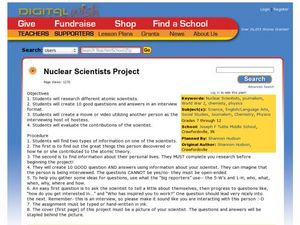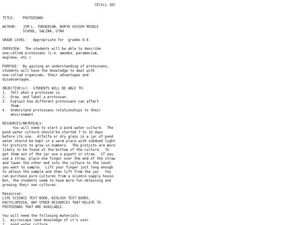Curated OER
Acidity
Sixth graders describe the physical and chemical properties of acids. In this chemistry lesson, 6th graders test the acidity of different solutions. They identify acids and bases using the pH scale.
Curated OER
Energy and Conservation
Touching upon energy sources and the causes of pollution, this PowerPoint could be expanded. For example, it describes the greehnouse effect and the problems associated with global warming, but does not indicate that the greenhouse...
Curated OER
Physical and Chemical Changes
In this changes worksheet, students observe and record changes that occur in their every day life and classify these changes as either physical or chemical change. Students record their information in a graphic organizer.
Curated OER
Investigating the Effect of Salinity on the Density and Stability of Water
Water with varying amounts of dissolved salt are dyed and then used to compare densities. The objective is to discover the effect of salinity, and therefore density, on ocean water on the stability of the ocean. Many branches of science...
Curated OER
Carbon Atom Mobile
Students research the element of carbon, its composition, and the importance of carbon to life on earth. Then they design model mobiles of carbon atoms to demonstrate their understanding of the configuration of protons, neutrons, and...
University of Colorado
Patterns and Fingerprints
Human fingerprint patterns are the result of layers of skin growing at different paces, thus causing the layers to pull on each other forming ridges. Here, groups of learners see how patterns and fingerprints assist scientists in a...
Curated OER
Selected Elements
This collection consists of a slide on each of the following unrelated, but fascinating elements: einsteinium, curium, radium, radon, nobelium, seaborgium, silicon, magnesium, and postassium. You will not find detailed information on the...
Curated OER
Investigating Properties of Water: Temperature
Investigate how temperature affects the density of water and stratification that occurs in bodies of water when temperatures vary. Water of differing temperatures is given different colors to see the layers that form. The lesson is meant...
Curated OER
Let's Make a Tubeworm!
Pupils discuss deep-sea chemosynthetic communities then create a poster of a three-dimensional tubeworm. In this creative lesson students create their own tubeworm and write a written report on it.
Curated OER
Activity #16 Dancing Spagehetti
Students experiment with floating the spaghetti, the gas functions like a life preserver. Pupils comprehend that a person is slightly more dense than water. They comprehend that a life preservers are made of low-density materials. The...
Curated OER
Water
Students conduct a series of investigations on the unique properties of water. In this general science activity, students explain what causes water's surface tension. They explain the different stages in the water cycle.
University of Southern California
Mastering Microbes
Small but mighty! Learners explore the role of microbes in a healthy ecosystem. An engaging activity asks pupils to design an aquaponics system that demonstrates that healthy microbes are necessary to maintain the ecosystem.
Curated OER
Hopping For Candy
Students explore recipes online for different types of candy, and simulate process of making candy to explain how candy makers rely on varied temperatures and basic chemistry to produce perfect sweets.
Curated OER
Freshwater Sharks Bite Children at 35th Beach. A Play
Young scholars delve into a study of sharks. In this science lesson plan, students examine the many different scientific occupations, as well as some possible specializations therein, and perhaps a little bit of other life...
Curated OER
Nuclear Scientists Project
Students explore nuclear scientists. In this nuclear science research lesson, students choose a scientist who has contributed to nuclear theory, research his/her life and accomplishments, and write a paper. Students generate...
Curated OER
Protozoans
Students examine protozoans and their advantages and disadvantages. In this chemistry lesson students explain what a protozoan is then draw and label one.
Curated OER
Activity #9 Extending Oil Well Production
Middle schoolers simulate methods used to extend the effective life of an oil well by extracting less available oil. They identify techniques which can be used and evaluate their effectiveness. Pupils are introduced to rock size and...
American Museum of Natural History
Climate Change
It actually is possible to have too much of a good thing when it comes to climate change. A slide show lesson describes how burning fossil fuels contributes to climate change. Individuals read about the scientific process and the...
Newspaper Association of America
Cereal Bowl Science and Other Investigations with the Newspaper
What do cereal, fog, and space shuttles have to do with newspapers? A collection of science investigations encourage critical thinking using connections to the various parts of the newspaper. Activities range from building origami seed...
Space Awareness
Ocean Acidification
Learn the science behind ocean acidification and its effects on ocean wildlife. Young scientists conduct a laboratory investigation that monitors the acidity level of water. While burning a candle, learners capture the carbon dioxide in...
Mascil Project
Epidemics: Modelling with Mathematics
The Black Death epidemic is responsible for more than one million deaths in the United Kingdom. An inquiry-based activity has young scholars explore the rate of disease spread. They then analyze graphs showing data from epidemics such as...
Curated OER
Fun Polymer Activity
Students add borax to a latex polymer and play with it to see the characteristics it now contains. In this polymer lesson plan, students see if it stretches, if it's durable, if the molecules break easily, and more.
Curated OER
Polymers-Greaaaaaat Biiiiiig Molecuuuuuules
Students explore polymer properties. In this lesson about polymers, students perform an experiment to understand polymers, their properties, and that they are formed from small molecules. Students role play pretending they are polymer...
Curated OER
You Light Up My Life: Developing a Scientific Theory for What Fuels a Candle's Flame!
Students examine how candles work and how scientific theories are developed and tested. Students propose hypotheses about what is burning in a candle then perform tests in order to develop their scientific theory. After a teacher...
Other popular searches
- Biology Chemistry of Life
- Chemistry of Life Unit
- Chemistry of Life Worksheet
- Chemistry of Life Holt
- Chemistry of Life Answers
- The Chemistry of Life
- Nuclear Chemistry Half Life
- Marine Water Chemistry
- Chemistry in Daily Life
- Life Skills Lesson Chemistry

